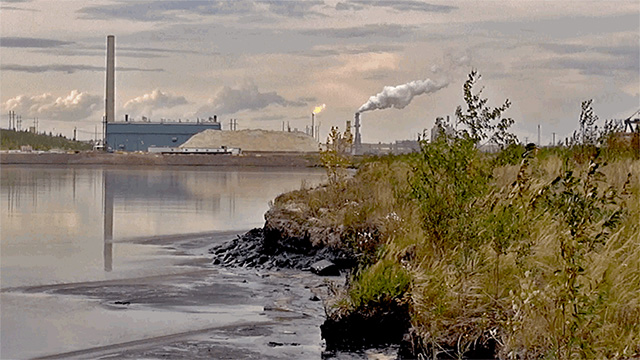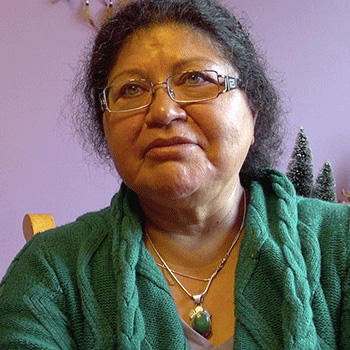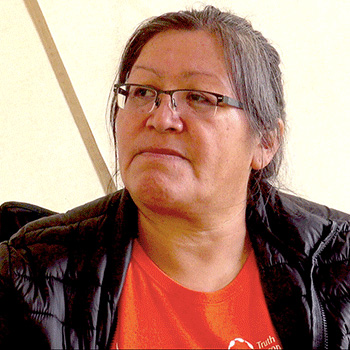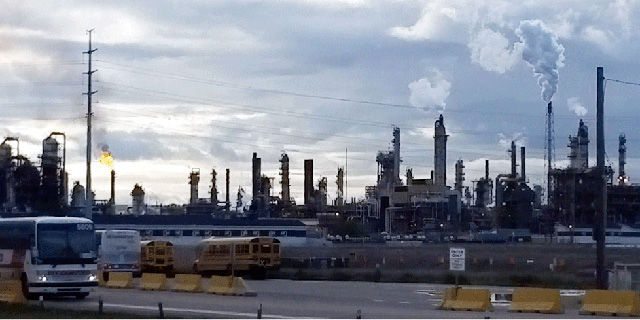
More than 860 miles northeast of the Unist’ot’en clan’s British Columbia blockade is the Athabasca river valley, where the five First Nations of the region know too well what it’s like to live with big oil and gas in their backyard.
Home to the third-largest proven reserves of crude oil in the world, the Alberta tar sands hold an estimated 17 Cleo Reese is an environmental activist and band councillor for Alberta’s Fort Murray No. 468 First Nation. She has been a central organizer in the annual healing walks that have taken place in Alberta since 2010. “If the land is OK, the people are OK. But if the land needs healing, the people need healing, too,” Reese says. (Photo: Amanda Creech)5 billion barrels and are exceeded in volume only by Saudi Arabia and Venezuela. Here, First Nations engage in a complex dance of resistance to and cooperation with industry in order to survive.
Cleo Reese is an environmental activist and band councillor for Alberta’s Fort Murray No. 468 First Nation. She has been a central organizer in the annual healing walks that have taken place in Alberta since 2010. “If the land is OK, the people are OK. But if the land needs healing, the people need healing, too,” Reese says. (Photo: Amanda Creech)5 billion barrels and are exceeded in volume only by Saudi Arabia and Venezuela. Here, First Nations engage in a complex dance of resistance to and cooperation with industry in order to survive.
On a day in late August, a colorful, hand-drawn sign is propped in the front drive of James and Florence Woodward’s home on the Fort McMurray First Nation Reservation. It reads: “Healing Gathering for the Land and Water.”
The Woodwards’ home is perched on the edge of Gregoire Lake, where water gently laps on a curved pebble shore. Whitefish caught that morning dry on a wire mesh hanging over a fire pit in the yard. A tipi is about to be erected in the lawn.
Indigenous and nonindigenous people from across Alberta sit on plastic folding chairs near the water’s edge, holding paper plates filled with seasoned moose meat, warm traditional Bannock bread, and cups of hot Labrador tea. Grown near the lake’s edge, the tea leaves were collected the day before during an elder teaching on medicinal plant usage and foraging techniques.
The Woodwards’ cousin Cleo Reese is a key organizer of this three-day gathering, which includes traditional pipe ceremonies, sweat lodges, language teachings, and a healing prayer walk around the toxic tailings ponds just north of Fort McMurray, on the First Nation’s traditional hunting grounds. “If the land is OK, the people are OK. But if the land needs healing, the people need healing, too,” says Reese.
The healing walks, begun in 2010, were initially a way to grow support around the issue of tar sands development. They expanded from 300 people to several thousand in 2014, including famed climate activists Naomi Klein and Bill McKibben. This year, the purpose is more inward Reese says: To reconnect First Nations people with their land, language, and culture – a relationship destabilized by the intergenerational trauma of residential schools throughout the 20th century, and then further degraded by the downturn of the trapping industry and the efforts of government and industry to bring tar sands oil to the world.
North of the Fort McMurray reservation, once-rich boreal forest has been scraped away to make room for new drilling sites. There, the Syncrude refinery looks like a city, with myriad smoke stacks pushing out dark clouds. Directly to the west, megaload trucks carry building-sized machinery parts on Highway 63 – referred to by locals as the “highway to hell” – while 18-wheelers haul lumber, I-beams, and flammable natural gas.
As recently as the 1980s, many indigenous people in this region could rely on fur trapping to provide household income. When the trapping industry suffered a sharp downturn – pelt production fell 62 percent in the early 1990s because of animal rights groups’ vocal opposition – First Nations people were forced to find other means of employment. Oil companies were there to fill the void.
The industry offers jobs, says Reese, whose daughter earns a good income working in the tar sands operation. First Nations also garner economic benefits in exchange for cooperation on development projects. But with the money comes the heartbreak of environmental devastation and the accompanying health issues.
The Fort McKay First Nation is the richest First Nation in Alberta, from oil deals and income brought in by the Nation-owned Fort McKay Group of Companies Limited Partnership, which offers industry services including heavy equipment operation, site servicing, reclamation support, and logistics. Formed in 1986 with a single janitorial contract, the company now reports $150 million in annual revenue, with 1,000 employees, 20 percent of whom are Native.
Jean L’Hommecourt, a traditional land-use researcher for the Fort McKay First Nation, is one of the most vocal band members against tar sands development. Despite this, she recognizes that since her community can no longer live off the land, working with industry is essential for the band’s survival. “We have to get into business with the companies in order to get some of that money, some of the resources from our land,” she says.
Resistance to development projects is an extremely expensive and labor-intensive process, says Lisa King, director of the Industry Relations Corporation for the Athabasca Chipewyan First Nation. When a company proposes a project, it’s the Industry Relations Corporation that looks at the Environmental Impact Assessment of the project. Under the direction of elders, the Nation decides whether to oppose the project and defend their decision through a lengthy and expensive hearing process or to partner with project developers and reap benefits.
“Just getting your studies and your evidence ready, your scientists ready, getting your communities of people who are out on the land – it’s a lot of work and a lot of money,” says King.
(Video: Amanda Creech)
When a Nation decides to partner, that can work as leverage to win contracts for Nation-owned companies that in turn bring jobs and benefits for the community. Lack of capacity and funds, King says, means that the Nation reserves its energy and resources for the biggest, most environmentally destructive projects.
Currently the Athabasca Chipewyan First Nation is preparing to fight a proposal by Tech Resources to build another large open pit mine. The hearing is scheduled for 2016.
Former Prime Minister Stephen Harper in 2006 famously claimed that oil extraction from the tar sands was an enterprise akin to China’s Great Wall, “only bigger.” While the size of the reserves is impressive, the simple narrative that the tar sands are producing and exporting oil is a sleight of hand. Rather, what flows through many of the hundreds of pipelines in Alberta is “dilbit,” or diluted bitumen, a mixture of a heavy, tar-like hydrocarbon called bitumen mixed with chemically “processed” water, sand, and natural gas condensate. The Natural Resources Defense Council says the substance is “highly corrosive,” “acidic,” and “potentially unstable.”
Many Canadian environmental organizations and First Nations have expressed concern about the impacts of transporting such a chemically volatile substance through pipelines that have a history of ruptures and spills. And Tony Boschmann, the environmental consultation manager for the Fort McMurray First Nation, believes that running dilbit through these pipelines significantly complicates the process of cleanup in the event of spills.
One such spill occurred in July 2015, just 5 miles from the Woodwards’ home. When a pipeline owned by Nexen, a Chinese-owned energy company, burst, an estimated 31,500 barrels of dilbit emulsion leaked into the surrounding muskeg and wetlands.
Boschmann toured the site of the spill, describing it as a “mass of tar” spread over an area 980 by 230 feet and 8 to 12 inches deep.
With a standard oil spill, emulsions float on top of the water or land. A bitumen spill behaves differently. When the material cools, tar separates from processed water, sinking into the ground before it can be cleaned.
This leaves a lot of questions as to the full environmental impact of a dilbit spill. Regarding the Nexen spill, Boschmann wonders, “How far will that travel? How much habitat will that effect? How long will that be in the system?”
The lesson for Boschmann “is that the industry hasn’t provided a good case for how to clean [bitumen] up.”
L’Hommecourt remembers a time when the Athabasca River was a highway system that sustained her community. Nation members used the waterways to fish, hunt moose, and trap beaver. With industry pollution, refineries siphoning the river for cooling and processing, and the impacts of climate change, that life is no more, she says. “Now the river is very low. It’s hard to navigate – and dangerous.”
Access to clean water is a major issue for her Nation. Despite an expensive water treatment plant in Fort McKay, residents truck in water for drinking and bathing because carcinogenic chemicals in the local water have caused burns and lesions.
Water tables, James Woodward adds, have dropped all over the region, impacting beaver trapping and fishing. The NRDC has attributed this to the oil industry’s practice of extracting fresh water from underground aquifers to use in mining operations. Woodward, a Fort McMurray First Nation elder, says he and his wife, Florence, still eat very traditionally, relying heavily on fishing, hunting game, and foraging berries but must travel farther and farther each year to find food that has not been contaminated.
“There’s no more ground water,” says Woodward. “You can see empty beaver houses, empty ponds everywhere that used to have a lot of water.”
 A traditional land use researcher for the Fort McKay First Nation, Jean L’Hommecourt is an outspoken activist on the impacts that the tar sands have had on her community. Her community used to rely on the Athabasca River to fish and travel. “Now the river is very low. It’s hard to navigate – and dangerous.” (Photo: Amanda Creech)Both Woodward and L’Hommecourt have lived in the Athabasca River Valley for most of their adult lives. They’re traditional ecological knowledge holders. It’s exactly this kind of long-view historical understanding of the land, Boschmann says, that is so often left out of science reports on potential development impacts on land and people.
A traditional land use researcher for the Fort McKay First Nation, Jean L’Hommecourt is an outspoken activist on the impacts that the tar sands have had on her community. Her community used to rely on the Athabasca River to fish and travel. “Now the river is very low. It’s hard to navigate – and dangerous.” (Photo: Amanda Creech)Both Woodward and L’Hommecourt have lived in the Athabasca River Valley for most of their adult lives. They’re traditional ecological knowledge holders. It’s exactly this kind of long-view historical understanding of the land, Boschmann says, that is so often left out of science reports on potential development impacts on land and people.
Boschmann has proposed having First Nations residents conduct on-the-ground monitoring and then consult with elders to bring elements of that traditional ecological knowledge to dry environmental assessment reports.
The Fort McMurray First Nation has formalized its proposal and currently has five teens trained by Alberta’s Environmental Monitoring and Evaluation and Reporting Agency (AEMERA) in a new youth-to-elder exchange to expand the amount of cultural input in Western reports. Boschmann hopes this form of intergenerational reporting on the land can be used as a template for other First Nations in their fight to be heard.
Trucks speed along the curving highway around the vast Suncor tailings ponds, dikes holding in a shimmering blue-iridescent expanse of processed sand, bitumen, napthenic acids, and heavy metals. When it’s hot, some of the tailings evaporate into the air. After the first rain of the season, says Florence Woodward, a yellow film lines the edges of puddles and car windows.
It’s mid-afternoon at the healing gathering, and a group of 16 indigenous and nonindigenous people stand near the tailings edge, close enough to breathe in the acrid chemicals. Some in the group have only heard about the tailings. Others drive past them every day.
 North of the Fort McMurray reservation, once-rich boreal forest has been scraped away to make room for new drilling sites. There, the Syncrude refinery looks like a city, with myriad smoke stacks pushing out dark clouds. (Photo: Amanda Creech)
North of the Fort McMurray reservation, once-rich boreal forest has been scraped away to make room for new drilling sites. There, the Syncrude refinery looks like a city, with myriad smoke stacks pushing out dark clouds. (Photo: Amanda Creech)
Five grandmothers lead the way to witness for themselves the black muck that wells and crusts on the edge of the ponds. On the water’s surface, disembodied human forms rise from the inky blackness – scarecrows installed to warn away birds from landing on the ponds and dying in the muck.
In the Athabasca River indigenous tradition, grandmothers are the ultimate life-givers. They are the carriers of wisdom and power.
Carefully, they open several small containers of fresh water that they’ve blessed and add it to the tailings – an offering of healing and a prayer to keep on fighting.
Join us in defending the truth before it’s too late
The future of independent journalism is uncertain, and the consequences of losing it are too grave to ignore. To ensure Truthout remains safe, strong, and free, we need to raise $24,000 by the end of today. Every dollar raised goes directly toward the costs of producing news you can trust.
Please give what you can — because by supporting us with a tax-deductible donation, you’re not just preserving a source of news, you’re helping to safeguard what’s left of our democracy.